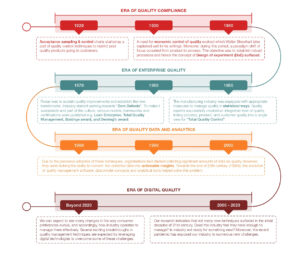Structured tools and techniques in quality management began early in the 20th century. Eventually, when
organizations realized the multi-faceted impact of quality on a company’s overall performance, quality became an integral part of the operating model. The following visual describes this evolution over the last century.

Quality management is becoming more effective by leveraging digital across the value chain. Digital has helped to strengthen quality by working closely with suppliers, focusing on internal processes and serving customers. Examples include:
1. Automated and intelligent process for SQI (Supplier Quality Improvement): Leverages digital on incoming inspection results to get actionable insights. AI applied on collected quality inspection data, automatically analyzes the potential quality risks and initiates supplier corrective action process (SCAR) embedded with supporting insights for internal teams to optimize quality parameters.
2. Digital Design of Experiments (DoE): DoE helps organizations to assess the impact of change in process input in relation to the output. Though effective, it is a long and time-consuming exercise requiring a pool of resources. With digital tools, this process can be done in real-time. 4M data (human, machine, material and method) is captured directly from machines, analysis is done using AI-based algorithms and optimization is done across multiple process stages in real-time.
3. Predictive Quality: There are various real-world scenarios for deploying video & image analytics for quality management. In the automotive industry, video & image analytics capture details of a part on the production line. AI-based algorithms are used to determine missing holes & nuts, count the total nuts and also map the coordinates of each hole to ensure a quality product.
4. Remote Monitoring for Quality: Operational performance data of the machines or products is collected for root cause analysis, which helps to carryout diagnosis remotely. Remote monitoring enables continuous improvement in quality and on the other hand, performance data collected from machines provides increased visibility of sites for improved maintenance costs and reduced capital expenditures.
5. Proactive sensing to act before customers complain: In the present hyper-connected world with ever demanding customers, there are numerous platforms to feed us the pulse of product performance. Customer engagement applications,block chain & near field communications (NFC)-based smart packaging & traceability solutions, and big data analytics-based customer insights put you on top of the situation.

At Hitachi, we expect quality functions to evolve from descriptive to prescriptive in coming years. As the collection of data becomes more real-time and quality management documents become live, potential for on-line analytics on data sets will become feasible and hence, quality will move from descriptive to predictive. With further application of artificial intelligence and machine learning, it is expected to reach the end goal of being prescriptive.
